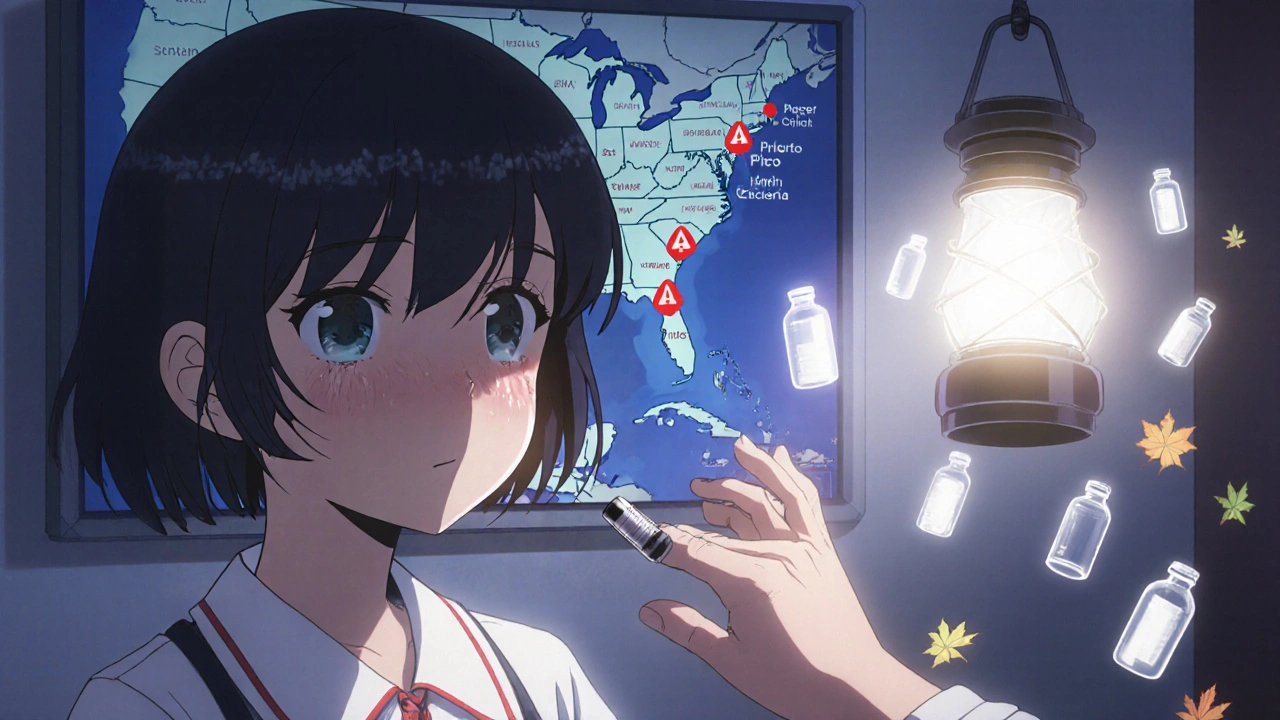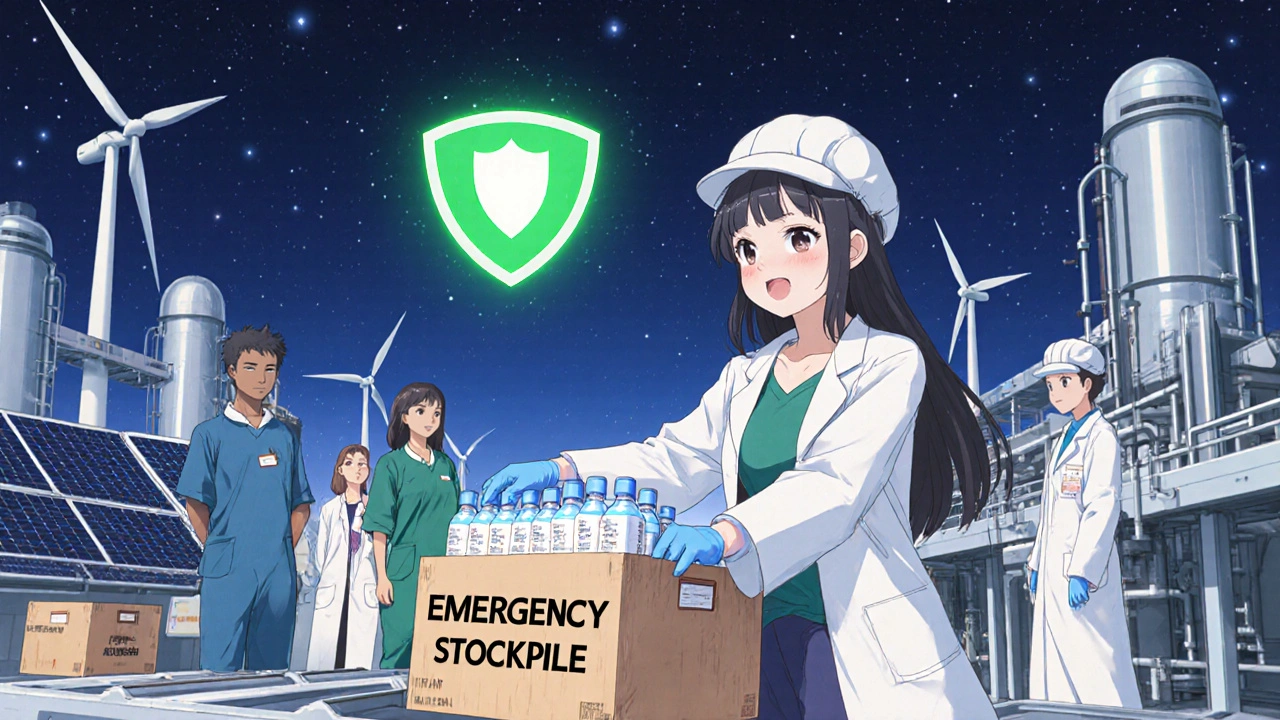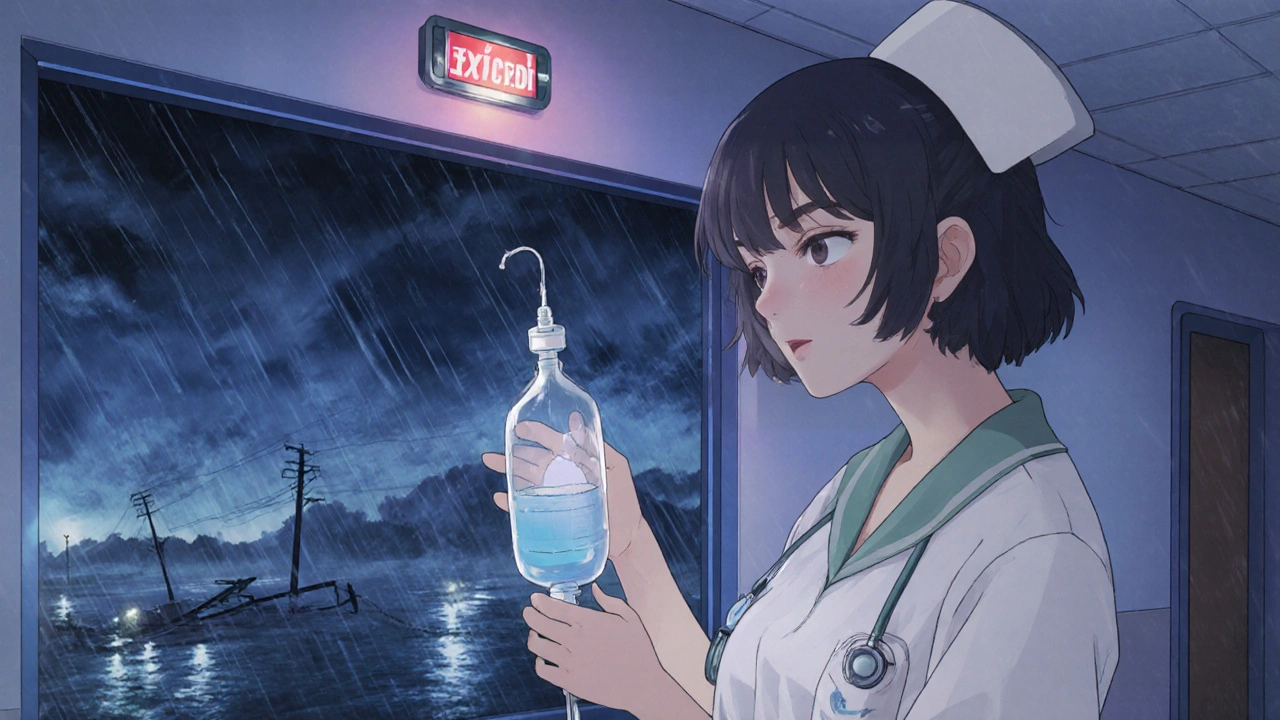When Hurricane Helene hit North Carolina in September 2024, most people thought about flooded homes and downed power lines. But for hospitals across the U.S., the real crisis was quieter-and deadlier. Inside a single plant in North Cove, a machine stopped working. That machine made IV fluids. And when it went offline, the country ran out of saline bags, the most basic, life-saving fluid used in every ER, ICU, and operating room. Within 72 hours, hospitals began canceling surgeries. Cancer patients waited for chemo. Newborns went without hydration. This wasn’t a glitch. It was a system failure, made worse by climate change.
Why One Storm Can Shut Down the Nation’s Medicine Supply
Puerto Rico used to make 10% of all FDA-approved drugs in the U.S. And 40% of sterile injectables-like insulin, antibiotics, and IV fluids-came from just a few factories on the island. When Hurricane Maria smashed into Puerto Rico in 2017, it didn’t just knock out power. It destroyed the electrical grids that kept refrigerated drug production lines running. The result? A nationwide insulin shortage that lasted 18 months. Hospitals rationed doses. Diabetics skipped injections. Some died. That wasn’t an accident. It was predictable. Over 65% of U.S. pharmaceutical manufacturing facilities sit in counties that have seen at least one federal weather disaster declaration since 2018. Hurricanes, floods, wildfires-they’re not just weather events anymore. They’re supply chain shocks. The problem isn’t just location. It’s concentration. Most critical drugs are made in just one or two factories. For example, Baxter’s plant in North Carolina makes 60% of the country’s IV fluids. If that one facility goes dark, there’s no backup. No spare parts. No quick fix. It takes 6 to 12 months to build a new pharmaceutical plant. And 2 to 3 years to install the specialized, ultra-clean equipment needed to make sterile drugs. You can’t just order more from Amazon.What Drugs Are Most at Risk?
It’s not just the fancy, expensive medicines. The most vulnerable drugs are the old, cheap, generic ones that no one thinks about-until they’re gone.- IV fluids (saline): Used in every hospital, every day. One plant in North Carolina made 1.5 million bags daily. After Helene, shortages hit 90% of U.S. hospitals.
- Insulin: 80% of U.S. supply came from Puerto Rico before Maria. Even today, only two major manufacturers make the most common types.
- Sterile injectables: Antibiotics like vancomycin, painkillers like morphine, and emergency drugs like epinephrine. 78% of these have only one or two U.S. production sites.
- Infant formula: The 2022 Michigan floods hit Abbott’s Sturgis plant during an existing shortage. The delay pushed nationwide scarcity into its 8th month.
Why Hurricanes Are the Worst Threat
Not all disasters hit the drug supply the same way. Hurricanes are the biggest killers.- Hurricanes: Cause 47% of climate-related drug shortages. They knock out power for weeks, flood factories, and destroy transportation routes. Recovery takes 6 to 18 months.
- Tornadoes: 28% of disruptions. They hit hard but fast-like the 2023 tornado that damaged Pfizer’s plant in Rocky Mount, NC. It knocked out 27 specific drugs for 9 months.
- Floods: 19%. They ruin raw materials and packaging. The 2022 Michigan floods didn’t just stop formula production-they ruined millions of sealed containers.
- Wildfires & Heat: 6%. Less direct, but they disrupt logistics, damage storage facilities, and force shutdowns during peak demand.

What’s Being Done-And Why It’s Not Enough
The FDA now lists natural disasters as a top cause of drug shortages. That’s progress. But listing a problem isn’t fixing it. After Maria, the FDA created an emergency pathway to import drugs from Europe. It took 28 days. In a crisis, that’s too slow. Hospitals were running out of saline by Day 3. Some companies are trying. Sensos.io used AI to predict Helene’s impact 14 days ahead. A few hospitals used that warning to stockpile extra IV bags. That saved lives. But only 68% of big drugmakers now assess climate risk-and only 31% have actual plans to reduce it. The Strategic National Stockpile started piloting emergency supplies of critical injectables in hurricane zones. During Helene, that cut shortage duration by 40% compared to Maria. That’s a win. But the stockpile still holds enough for only a few days’ worth of demand. For a country of 330 million people, that’s not a safety net. It’s a Band-Aid.The Real Cost of Inaction
There’s a financial cost. The global market for pharmaceutical supply chain resilience is expected to hit $9.7 billion by 2029. But that’s not the real cost. The real cost is measured in delayed surgeries, missed chemo treatments, and preventable deaths. The American Society of Clinical Oncology warns that by 2027, cancer patients will face treatment delays during 8 to 10 major climate disasters every year-if nothing changes. And it’s not just about who gets sick. It’s about who gets left behind. Hospitals with 500+ beds are 3.2 times more likely to map their supply chains than small clinics. Rural hospitals, community health centers, and low-income urban clinics? They’re on their own.
What Needs to Change
Experts agree on three things:- Diversify production. Don’t make all your insulin in Puerto Rico. Don’t make all your IV fluids in North Carolina. Spread manufacturing across three climate-resilient zones-like the FDA’s new Critical Drug Resilience Program, launching in January 2025.
- Build strategic reserves. Keep 90 days of critical drugs in secure, geographically dispersed warehouses. The FDA’s proposed 2025 rule requiring this could prevent 60% of climate-related shortages.
- Fast-track approvals during disasters. Right now, getting emergency supplies approved takes weeks. It should take days. The FDA needs a real-time emergency channel, like a 911 line for medicine.
What You Can Do
You can’t build a new drug factory. But you can demand better.- Ask your doctor: "Is this medication at risk of shortage? Is there an alternative?"
- Support policies that fund drug supply resilience. Contact your representatives. Ask them to back the FDA’s 2025 rule on emergency inventories.
- Don’t hoard. Stockpiling drugs at home creates artificial shortages and wastes resources. Instead, stay informed and speak up.
Why do natural disasters cause drug shortages?
Natural disasters like hurricanes and floods damage pharmaceutical manufacturing plants, destroy power grids, and disrupt transportation routes. Many critical drugs are made in just one or two facilities, so when one shuts down, there’s no backup. It takes months to restart production, and even longer to build new facilities. This creates nationwide shortages of essential medicines like IV fluids, insulin, and antibiotics.
Which drugs are most likely to run out during a climate disaster?
The most vulnerable drugs are generic, sterile injectables used in hospitals: IV saline, insulin, antibiotics like vancomycin, painkillers like morphine, and emergency drugs like epinephrine. These are often made in single facilities with no redundancy. Infant formula and certain cancer drugs are also at high risk due to complex production and tight supply chains.
Are drug shortages getting worse because of climate change?
Yes. Between 2017 and 2024, climate-related disruptions caused 32% of all U.S. drug shortages. With more intense hurricanes and floods predicted, and over 65% of drug factories located in disaster-prone areas, shortages are expected to increase by 150% by 2030 if no changes are made.
Can the U.S. government fix this?
The FDA has started taking steps-like proposing rules that require manufacturers to keep 90-day emergency inventories and submit climate risk plans. A new program launching in January 2025 will fast-track approval for drugmakers who spread production across multiple climate-resilient regions. But progress is slow. Real change requires funding, regulation, and political will.
Should I stockpile medicine at home if a storm is coming?
No. Hoarding drugs creates artificial shortages and puts pressure on pharmacies and hospitals that serve vulnerable populations. Instead, talk to your doctor about alternatives, stay informed through official health alerts, and support policies that build long-term supply chain resilience.

Scarlett Walker
November 13, 2025 AT 13:24Honestly, I never thought about how a storm could mean no IV fluids for my grandma in the ICU. But now I get it-this isn’t just about weather, it’s about survival. We treat medicine like it’s just another product, but it’s literally life support. Time to stop treating it like a commodity.
Hrudananda Rath
November 15, 2025 AT 08:35One must observe, with profound intellectual consternation, that the American pharmaceutical infrastructure exhibits a lamentable dearth of systemic foresight. One is reminded of the Roman Empire’s reliance on a single grain silo-when the granary burned, the populace starved. We are now witnessing the same hubris, cloaked in corporate efficiency and globalized cost-cutting. The consequences are not merely economic-they are ontological.
Brian Bell
November 15, 2025 AT 19:23Bro. I just saw a TikTok of a nurse holding a saline bag like it was a diamond. 😭 We’re literally one hurricane away from not being able to give people water through a vein. This is wild. And we’re still arguing about taxes??
Nathan Hsu
November 16, 2025 AT 07:40Let me tell you, in India, we’ve seen this for decades-pharmaceutical production scattered across states, redundant supply chains, local manufacturing hubs. Why? Because we know nature doesn’t care about your quarterly earnings report. And yet, here you are, with billion-dollar pharma giants, and you still don’t have backup plans? Shocking. Truly shocking.
Ashley Durance
November 17, 2025 AT 07:27Let’s be real. The only reason this is a ‘crisis’ now is because it’s affecting white, middle-class patients. Rural clinics have been dealing with this for years. The fact that it took a hurricane hitting a Baxter plant to make headlines says everything about who gets prioritized in this system.
Scott Saleska
November 18, 2025 AT 02:05Wait, so if I’m a diabetic and I live in a rural town, and my insulin runs out because a hurricane shut down Puerto Rico, what do I do? Call the FDA? They’re still processing emergency imports after 28 days. Meanwhile, I’m out of meds. And you want me to ‘speak up’? I’m already too busy trying not to die.
kshitij pandey
November 18, 2025 AT 14:31My friend in Kerala runs a small clinic. They keep extra insulin in coolers with ice packs, just in case. No fancy AI. No government backup. Just people being smart. We can do this. We just need to stop waiting for big companies to save us. Start local. Think simple. Share what you have.
Anjan Patel
November 19, 2025 AT 17:27Oh, so now climate change is ‘killing’ people because the rich don’t want to pay more for medicine? Wake up! This isn’t a tragedy-it’s a moral failure. The CEOs who moved production overseas to save pennies are the ones who should be in jail. And you want me to ‘ask my doctor’? My doctor has no power. The system is rigged.
Ryan Anderson
November 20, 2025 AT 02:29Just read this article and cried. I work in a hospital. We’ve had to ration saline. We’ve had to delay chemo. We’ve had to tell parents their baby might not get fluids because the factory flooded. This isn’t hypothetical. It’s Tuesday. And we’re still not acting like it’s an emergency. 🫡
Kevin Wagner
November 21, 2025 AT 03:12Y’all are sleeping on this like it’s a bad Yelp review. This is the next pandemic. Not a virus-something way worse: a system that thinks profit matters more than life. We need to treat medicine like electricity or water. You don’t wait for the power to go out to build a grid. You build it before the storm hits. Let’s stop being passive and start being furious. 🔥
Dilip Patel
November 22, 2025 AT 23:02Peter Aultman
November 23, 2025 AT 14:12My cousin works at a small clinic in West Virginia. They got a shipment of saline 3 weeks after Helene. No one told them it was coming. They just showed up one day. That’s not a system. That’s luck. We need to stop hoping for miracles and start building real backups.
Sean Hwang
November 25, 2025 AT 10:00Biggest thing people miss: it’s not just about making more drugs. It’s about having people who know how to make them. The skilled workers who run those ultra-clean rooms? They’re aging out. No one’s training new ones. We’re running out of experts, not just medicine. And no one’s talking about that.